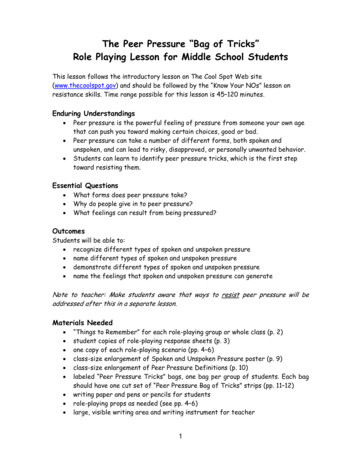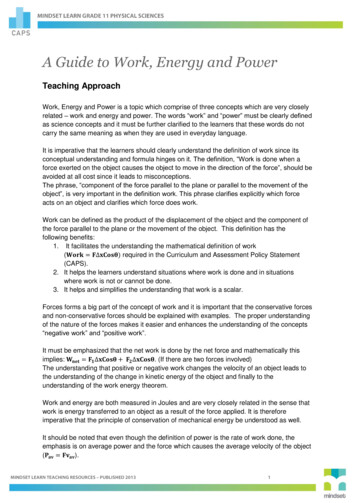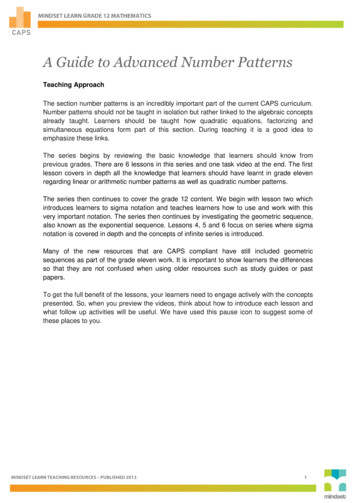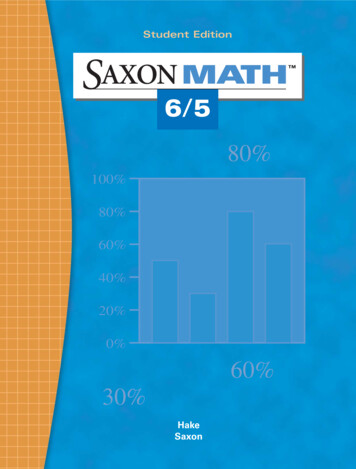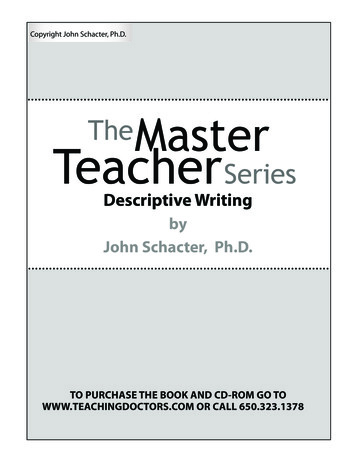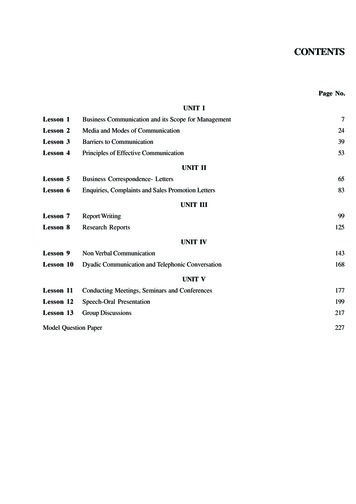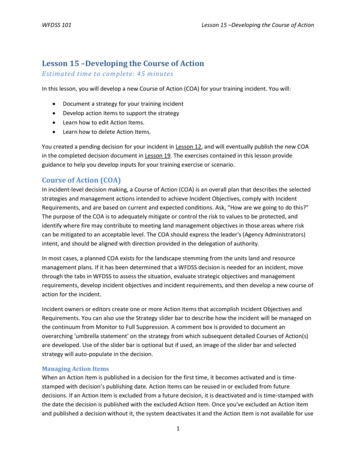
Transcription
WFDSS 101Lesson 15 –Developing the Course of ActionLesson 15 –Developing the Course of ActionEstimated time to complete: 45 minutesIn this lesson, you will develop a new Course of Action (COA) for your training incident. You will: Document a strategy for your training incidentDevelop action items to support the strategyLearn how to edit Action Items.Learn how to delete Action Items.You created a pending decision for your incident in Lesson 12, and will eventually publish the new COAin the completed decision document in Lesson 19. The exercises contained in this lesson provideguidance to help you develop inputs for your training exercise or scenario.Course of Action (COA)In incident-level decision making, a Course of Action (COA) is an overall plan that describes the selectedstrategies and management actions intended to achieve Incident Objectives, comply with IncidentRequirements, and are based on current and expected conditions. Ask, “How are we going to do this?”The purpose of the COA is to adequately mitigate or control the risk to values to be protected, andidentify where fire may contribute to meeting land management objectives in those areas where riskcan be mitigated to an acceptable level. The COA should express the leader's (Agency Administrators)intent, and should be aligned with direction provided in the delegation of authority.In most cases, a planned COA exists for the landscape stemming from the units land and resourcemanagement plans. If it has been determined that a WFDSS decision is needed for an incident, movethrough the tabs in WFDSS to assess the situation, evaluate strategic objectives and managementrequirements, develop incident objectives and incident requirements, and then develop a new course ofaction for the incident.Incident owners or editors create one or more Action Items that accomplish Incident Objectives andRequirements. You can also use the Strategy slider bar to describe how the incident will be managed onthe continuum from Monitor to Full Suppression. A comment box is provided to document anoverarching 'umbrella statement' on the strategy from which subsequent detailed Courses of Action(s)are developed. Use of the slider bar is optional but if used, an image of the slider bar and selectedstrategy will auto-populate in the decision.Managing Action ItemsWhen an Action Item is published in a decision for the first time, it becomes activated and is timestamped with decision’s publishing date. Action Items can be reused in or excluded from futuredecisions. If an Action Item is excluded from a future decision, it is deactivated and is time-stamped withthe date the decision is published with the excluded Action Item. Once you've excluded an Action Itemand published a decision without it, the system deactivates it and the Action Item is not available for use1
WFDSS 101Lesson 15 –Developing the Course of Actionin future decisions. If you want to include a deactivated Action Item in a future decision, you mustrecreate it.Developing a Course of ActionThe Course of Action (COA) tab is where Incident Owners and Editors describe the overall firemanagement strategy and develop and document one or more Action Items that will accomplish theIncident Objectives and Requirements developed for an incident. The COA should express the leader's(Agency Administrator) intent, and should be aligned with direction provided in the delegation ofauthority. A COA is a required part of a decision and must contain at least one action item.On the COA tab, you can: Set a Strategy slider bar to describe how the incident will be managed on the continuum fromMonitor to Full Suppression (optional, image of slider bar appears in the decision if used).Write a comment describing the overall strategy for the incident as described by the sliderbar. This content may be thought of as an overarching 'umbrella statement' on the strategyfrom which subsequent detailed Course(s) of Action are developed (optional).Develop and document Action Items to be included in pending decisions and manage ActionItems that are included or excluded in previous, current or pending decisions.Filter the Action Item list to determine the active status for each or quickly identify which areincluded or excluded from a pending decision.Create a pending decision after you've developed your first Action Item (this option onlyavailable if you have not already created a pending decision from the Decisions tab.Action Items are automatically included in the decision content whereas the strategy slider only appearsif you choose to use it. Once a pending decision has been created, you can use the Decision Editor toadd, as appropriate, supporting text, map images, analysis outputs or pictures to clarify the COA(decision editors are only accessible after you’ve created a pending decision).Strategic ObjectivesMeasures for the protection ofcultural resources from vandalism& natural destruction will includeregular inspection and, wherenecessary, electronic monitoring.Incident ObjectivesUtilize MIST tactics on all partsof the District including SandiaWilderness to reducesuppression-related impacts toruins and cultural resources.Allow fire to play a natural role inWilderness.2Action Items Monitor fire and personnelactivities around ruins toassess and documentpotential damage tocultural resources. Utilize trail systems,changes in vegetation, andnatural barriers wherepossible. Monitor location of allactive flanks of the fire, inand around thearchaeological sites.
WFDSS 101Lesson 15 –Developing the Course of ActionStrategic ObjectivesProtect public & private facilities toprevent loss through wildfire.Incident ObjectivesPrevent loss and damage to allprivate and public facilitieswithin and near the fire areathat include the Visitor’s Centerand Cedro Campground.Action Items To protect structures,modify & improve fuelbreaks & roads inpreparation for the fireleaving the militarywithdrawal area. Monitor incident fromaircraft to determine timingand need for structureprotection.Management RequirementsMechanical equipment inWilderness must be authorizedprior to use.Incident RequirementsGet approval from DistrictRanger before using mechanicalequipment in SandiaWilderness.Action Items Assign a qualified fieldResource Advisor tomonitor mechanizedequipment use and overseerehab needs.Limit access to military withdrawalarea to existing maintained roads.To reduce risk to firefighters, donot leave maintained roadsystem (roads 22, 41, and 44) inthe withdrawal areaAir quality and smoke management Smoke management & air Set up smoke monitoringrequirements and reportingquality requirements &station in Tijeras.procedures will be met.reporting procedures for Appoint advisor to NMEDBernalillo County & NMED willand coordinate with NMEDbe followed, and are found indaily.the Southwest Region SmokeReporting Guide.Examples of Objectives and Requirements and associated Action ItemsNote how the Action Items, Incident Objectives/Requirements, and Strategic Objectives andManagement Requirements relate to one another.If the planning area is modified or new Incident Objectives and Requirements are added to a pendingdecision, the proposed COA should be modified, as needed, to ensure it still accomplishes IncidentObjectives and Requirements. A new COA, and a new decision, is warranted if the current, publishedCOA no longer accomplishes Incident Objectives and Requirements.Estimating Final CostOn the Costs tab, Incident Owners and/or Editors can:3
WFDSS 101 Lesson 15 –Developing the Course of ActionDocument the estimated final cost for an incident,Document the Cost Estimation Method used,Add comments about incident cost, andCreate/Edit and Accept/Copy/Delete SCI runs.The Estimated Final Cost is a required component of any decision and may be used to determine thesigning authority for an incident. The 2015 Interagency Standards for Fire and Fire Aviation Operationscontains additional Agency-specific information regarding WFDSS.To estimate a final cost for your incident, you can use: The cost estimate spreadsheet (available for download on the COA tab and from WFDSS Home Related Resources Tools)Stratified Cost IndexHistoric costs for incidents of similar size and complexityICARS ProjectionsSpreadsheetsOther methodsYou can publish a decision without selecting a cost estimation method. If you choose a method notlisted on the Costs tab, document the method and reasoning in the Cost Comment text box. You canalso use a decision editor to add supporting text or images if you choose.To document an Estimated Final Cost for an incident:1. From the Incident List, select the incident that you would like to document the EstimatedCost for.2. Click View Information. The Incident Information page appears.3. Click the Costs tab.4. Develop an Estimated Final Cost using a method listed, or one of your choosing. The CostEstimation spreadsheet may be a good method for this particular exercise.5. Enter the Estimated Final Cost.6. Select the Cost Estimation Method used to determine the Estimated Cost for the COA. If themethod isn’t listed, select Other. (If you selected Other, you would describe the methodused in the COA section of the decision using the Decision Editor. This will be covered inLesson 18.)7. Add Cost Comments if you choose.Editing an Action ItemIncident Owners and Editors can edit Action Items until a pending decision has been submitted forreview. Submitting a pending decision for review locks the decision content to prevent further editing.Once published in a decision, Action Items cannot be edited and can only be excluded from a pendingdecision.To edit an Action Item:1. From the Incident list, select the incident you want to edit Action Items for.4
WFDSS 101Lesson 15 –Developing the Course of Action2. Click View Information. The Edit Incident page appears.3. Select the Course of Action tab. The Course of Action page appears with a list of ActionItems near the bottom of the page.4. Select the Action Item you want to edit.5. Click Edit. The Edit Action item page appears.6. Edit the Action Item. Be as specific as possible. Remember, this information will appear inthe published decision and will guide the actions of incident management teams andresources assigned to the fire.7. Click Save.Deleting an Action ItemIncident Owners and Editors can delete Action Items that have not been included in a publisheddecision.To delete an Action Item:1. From the Incident list, select the incident you want to delete Action Items for.2. Click View Information. The Edit Incident page appears.3. Select Course of Action. The Course of Action page appears with a list of Action Items.4. Select the Action Item you want to delete.5. Click Delete.6. When asked if you are sure you want to delete the Action Item, click OK. The Action Itemhas been removed from the list.Search for these related topics in the help: Course of ActionDeveloping a Course of ActionDeleting Action ItemsAdding Text to a DecisionAdding an Image to a DecisionAdding Incident Content to a DecisionEstimating Cost for a Course of Action5
WFDSS 101 Lesson 15 –Developing the Course of Action 3 Strategic Objectives Incident Objectives Action Items Protect public & private facilities to prevent loss through wildfire. Prevent loss and damage to all private and public facilities within and near the fire area that inclu





